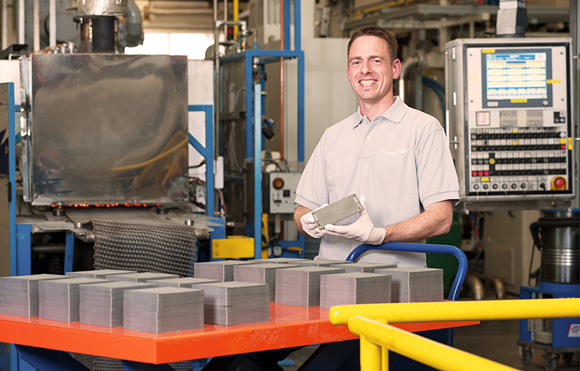Fuel cell with Powder Metallurgy interconnects runs successfully for ten years
October 18, 2017

Over the fuel-cell’s entire service life to date, the research centre team state that it has exhibited only a very low level of aging, at approximately 0.6% per 1000 operating hours (Courtesy Plansee)
A planar solid fuel cell developed at the Jülich GmbH Research Center, Jülich, Germany, has been running and producing electricity successfully for ten years. The high-temperature fuel cell, which has been studied throughout as part of a lifetime test, was built using Powder Metallurgy interconnects from Plansee SE, Reutte, Austria.
The lifetime test was launched on August 6, 2007, and is intended to demonstrate the durability of the solid oxide fuel cells developed by Jülich. In order for their operation to be economically efficient, these have to run for between 40,000 and 80,000 hours, or 5 to 10 years. According to Julich, no other fuel cell with ceramic cells has ever run for this long, and short lifetimes have in the past been regarded as the major flaw of this type of fuel cell.
Plansee’s interconnects were manufactured from ITM, an iron-based Oxide-Dispersion Strengthened (ODS) alloy with a 26% chrome content and very small amounts of yttrium oxide (Y2O3). An ODS alloy of this type can only be manufactured using PM techniques and is reported to offer crucial benefits in terms of SOFC high temperature fuel cell applications.
ITM withstands thermal and redox cycles for longer than other types of ferritic steels. Thanks to its outstanding corrosion stability, Plansee stated, it also ensures a particularly long service life.
Over the fuel-cell’s entire service life to date, the research centre team state that it has exhibited only a very low level of aging, at approximately 0.6% per 1000 operating hours. A further development to the stack in 2010 provided even better results, reportedly halving ageing over the next 34,500 hours of operation.
Although the Jülich test stack is still being operated in a laboratory environment, it contains all the components that a future commercial product would require. It is operated using hydrogen, which is converted into electrical current in the cell. Other fuels, such as natural gas, can also be converted and, according to other trials, may achieve higher levels of efficiency.
Further development of this cell technology is being undertaken in collaboration with the Jülich research centre. Plansee SE stated that it is working together with the Vienna University of Technology and AVL List GmbH to improve the service life of metal-supported high-temperature fuel cells. The aim is to investigate and optimise the electrode microstructures, the interactions between materials, and the reactive processes that occur at interfacial surfaces.
Applications for this type of fuel cell include in stationary power supply systems, such as for households or small businesses, but also for large vehicles such as trucks, trains and ships.















